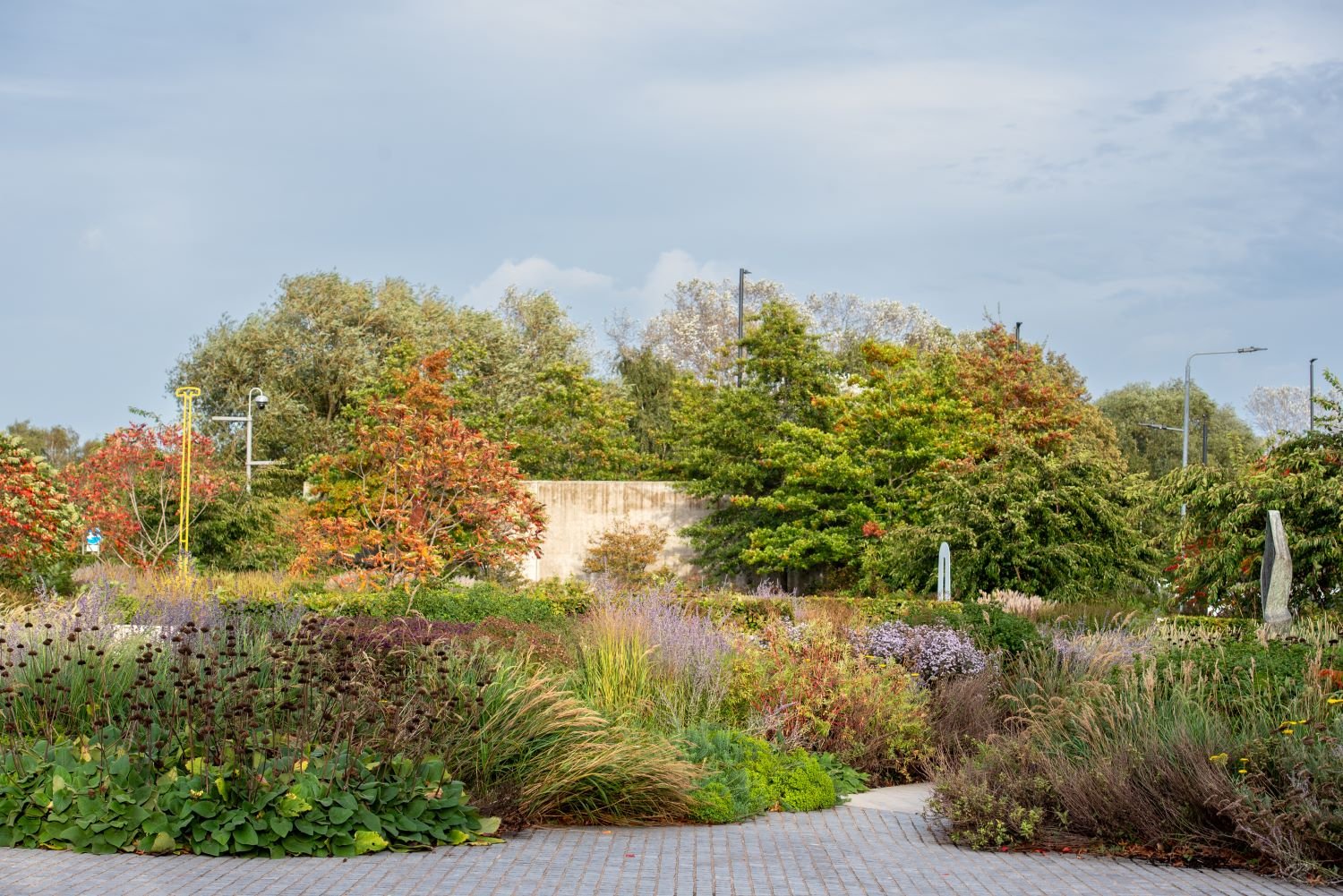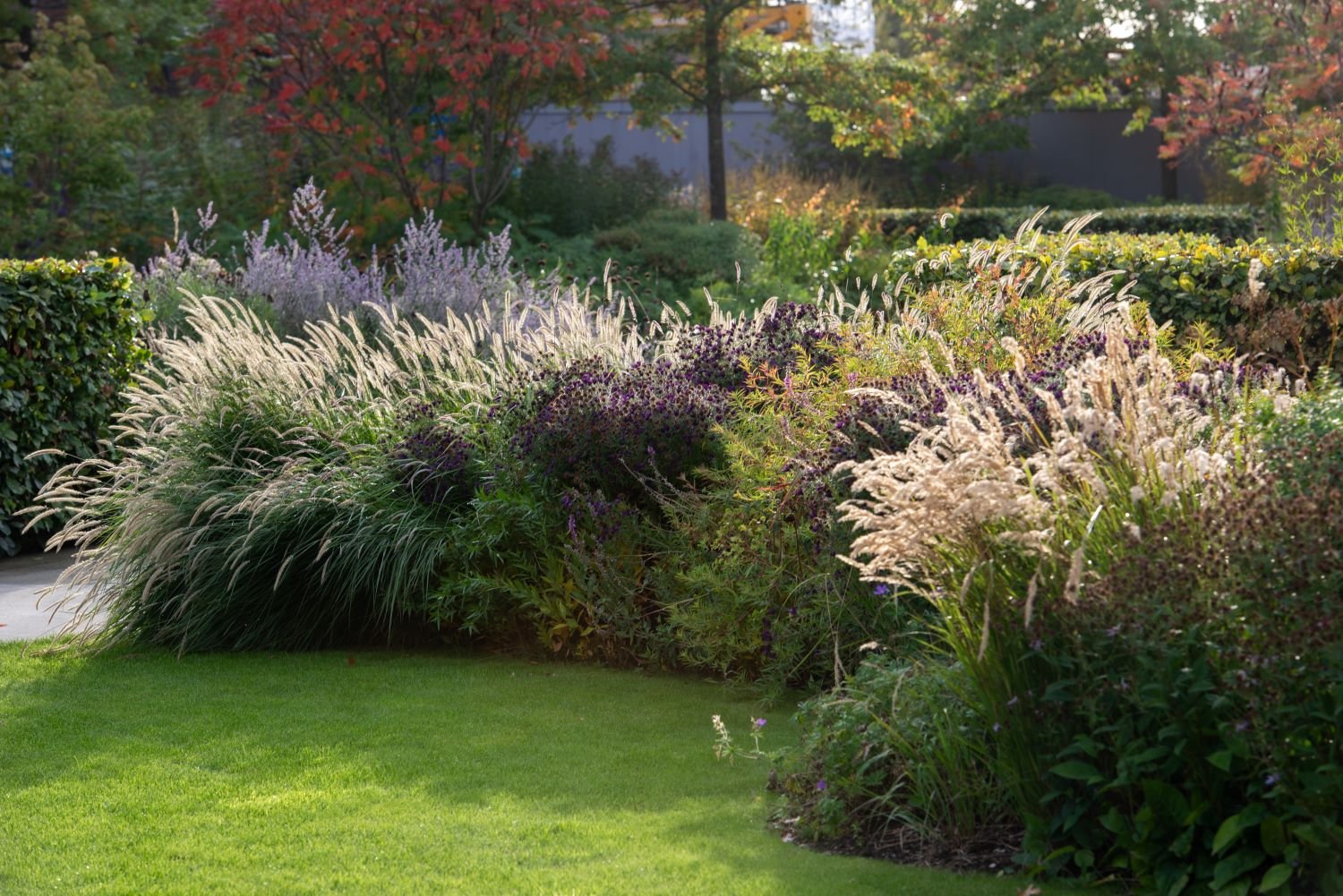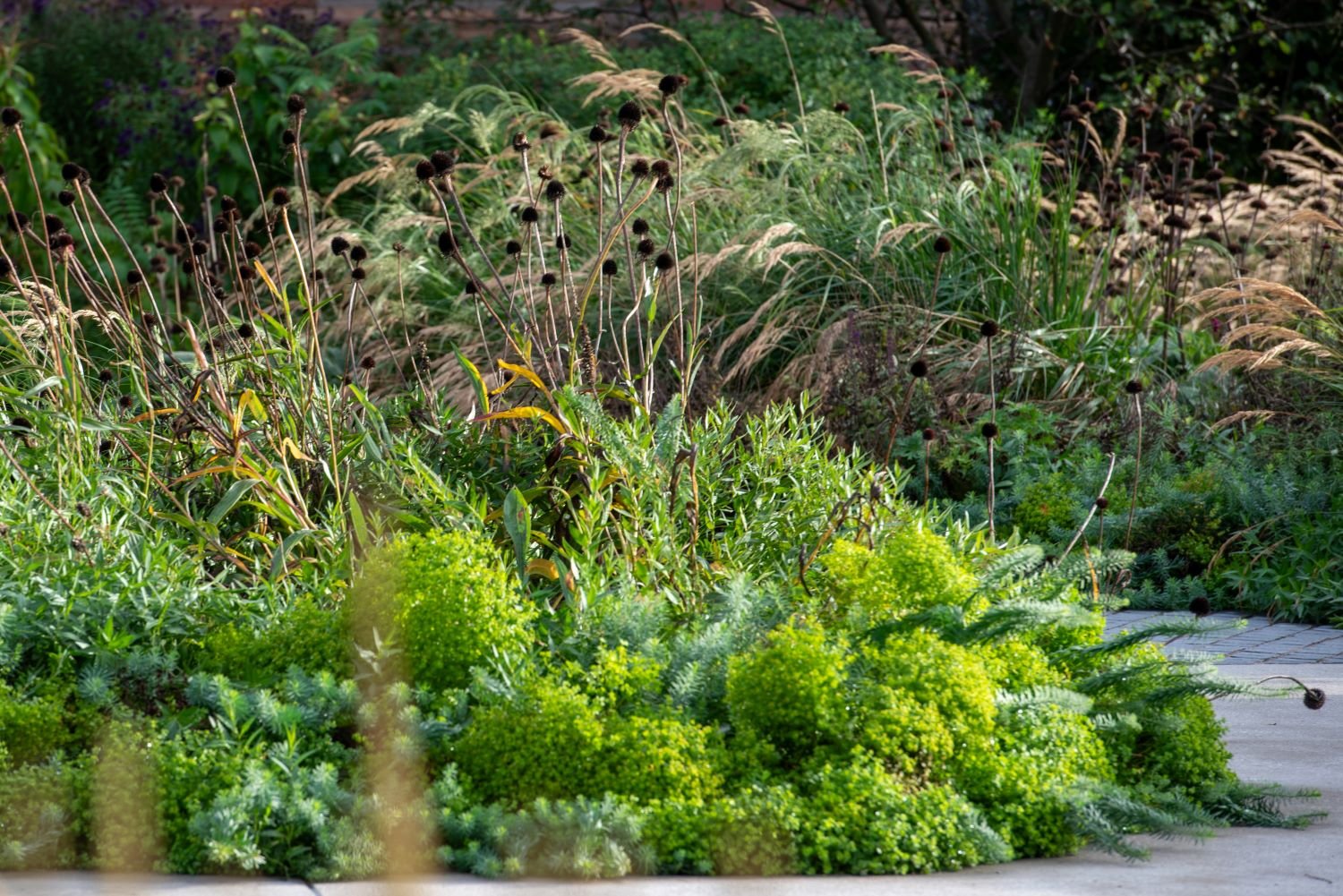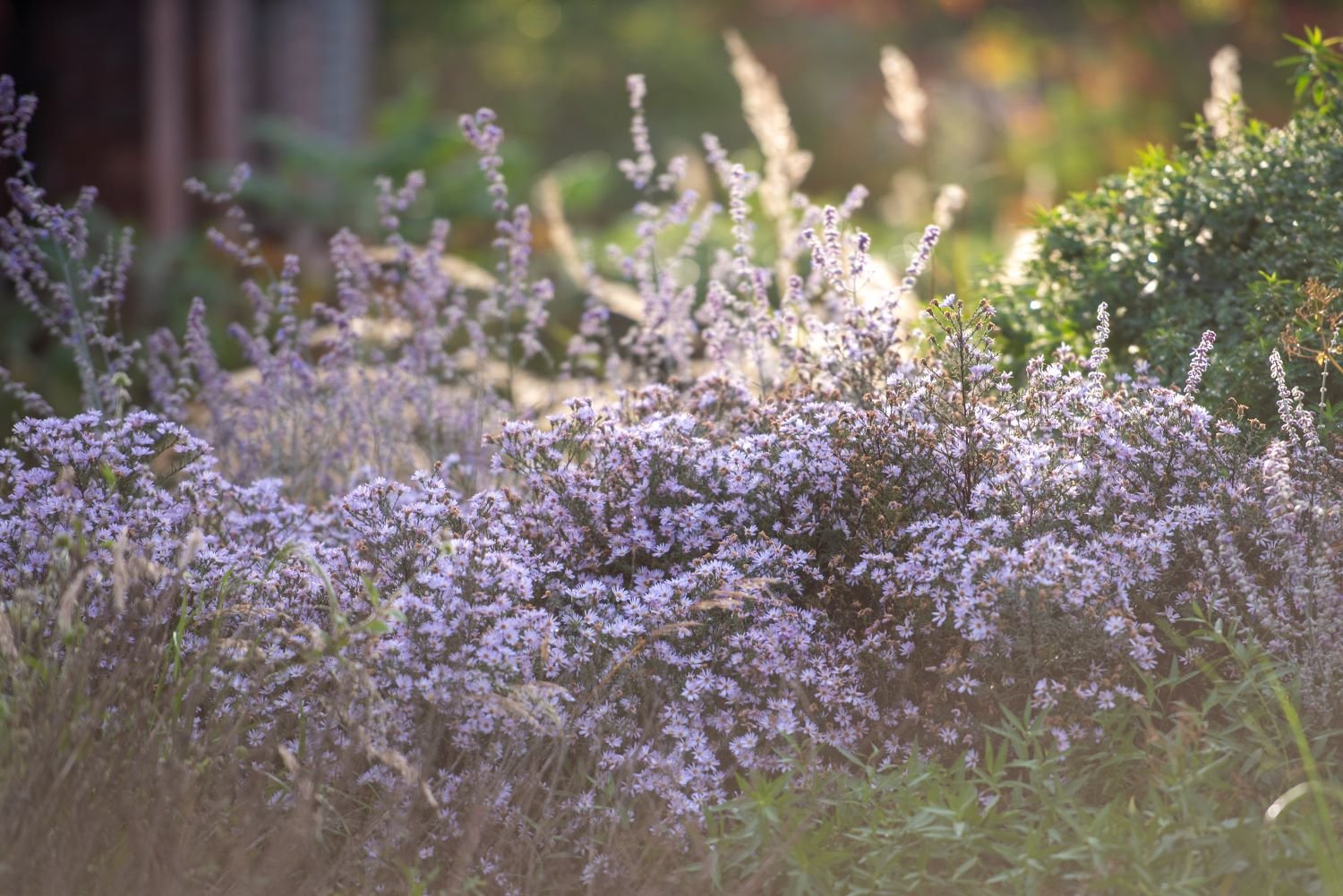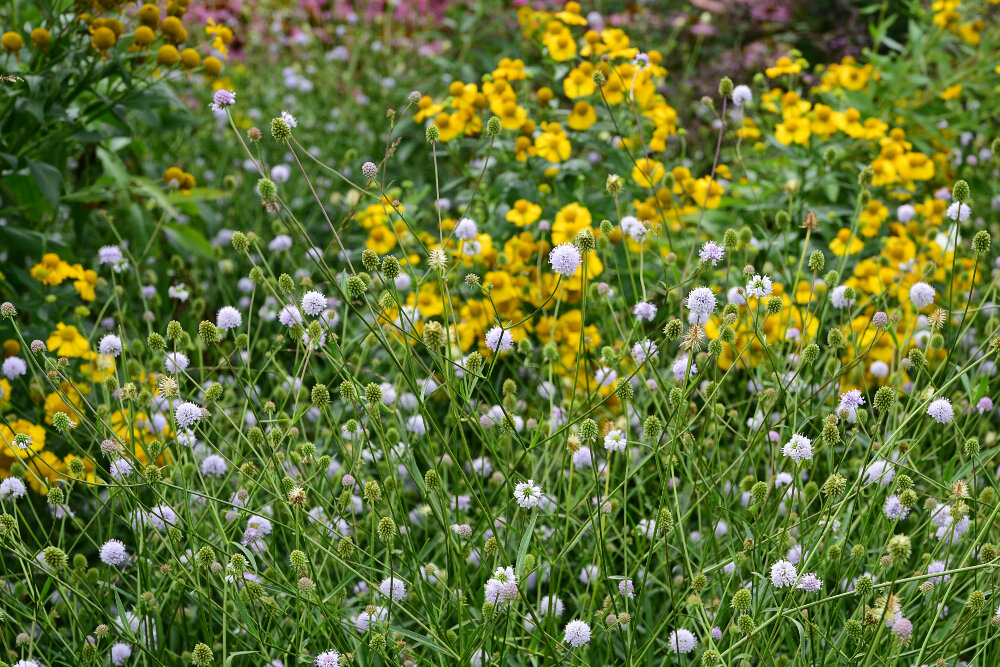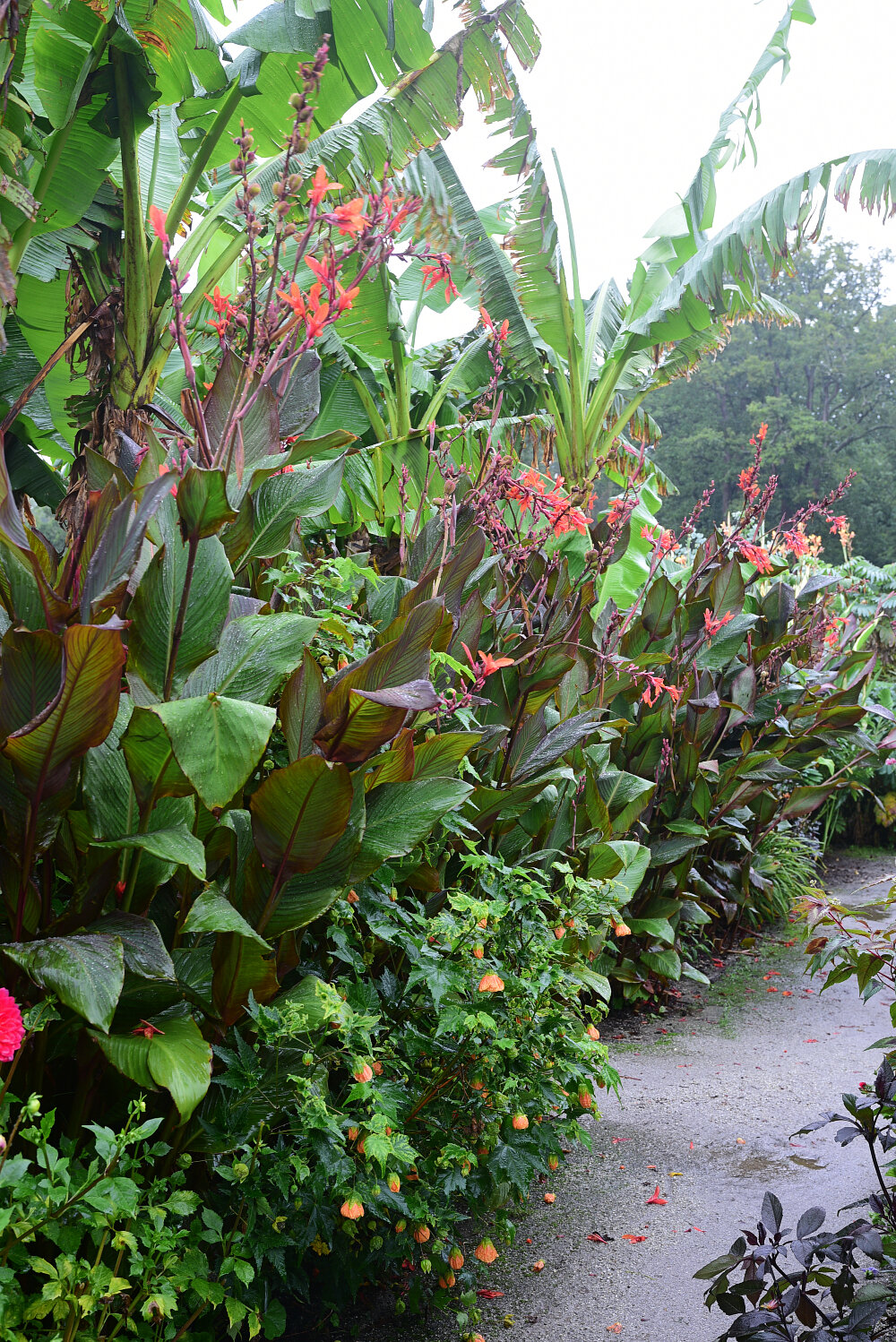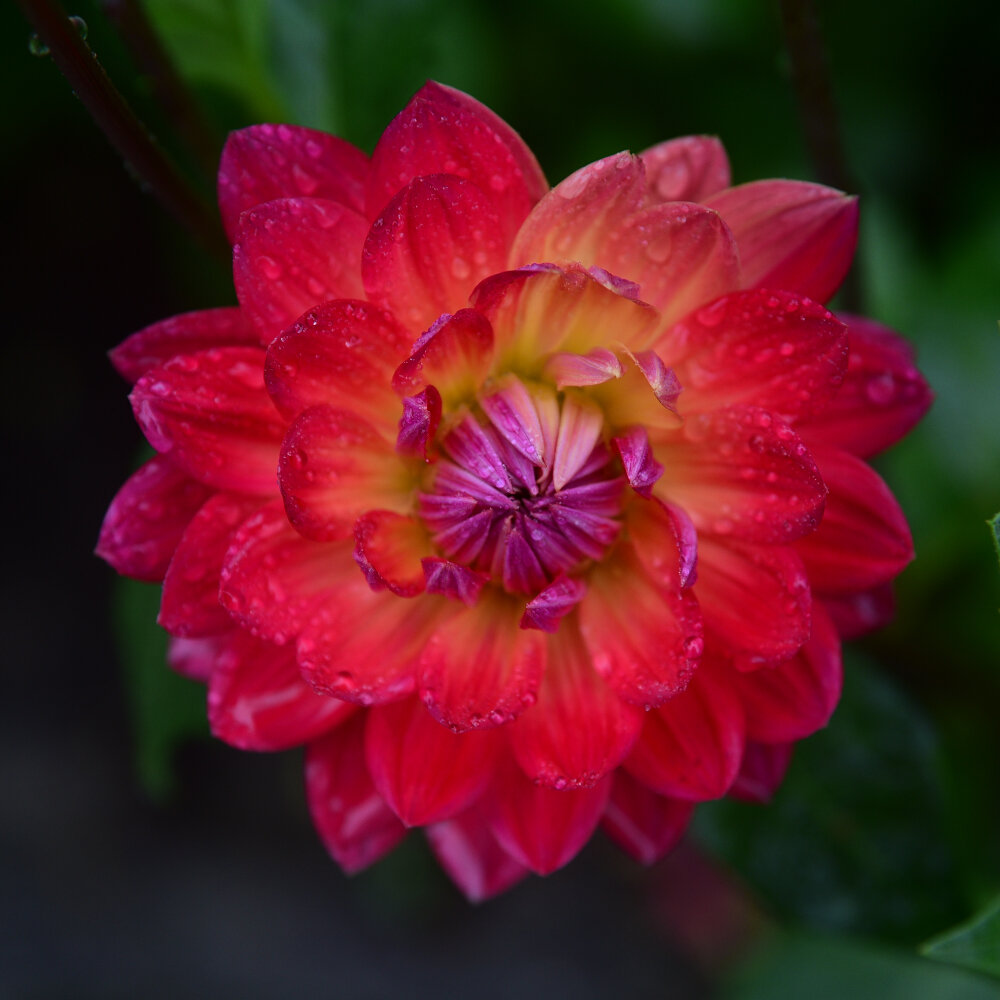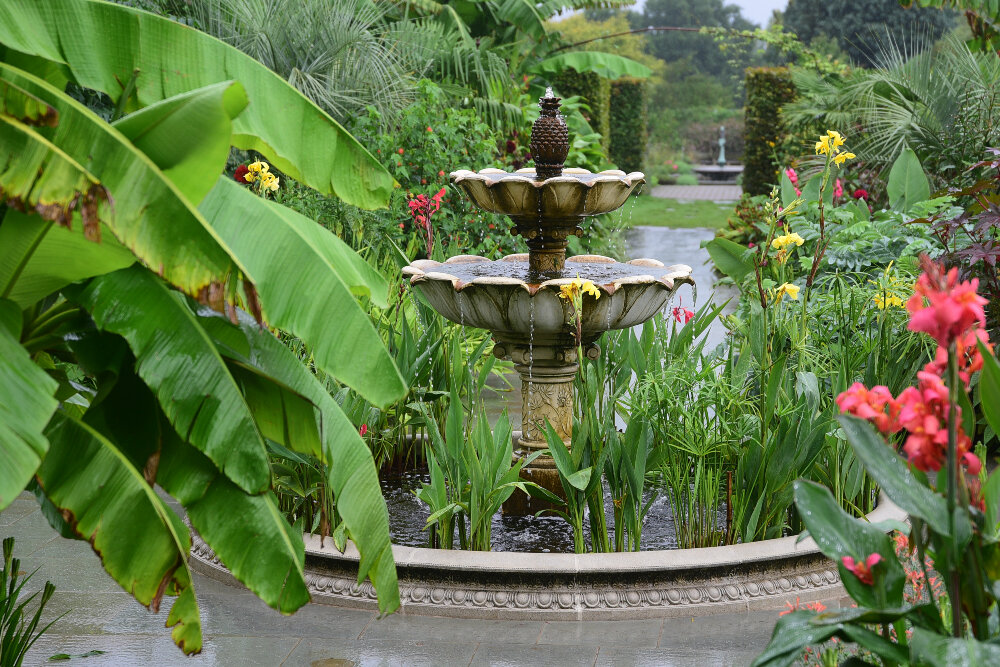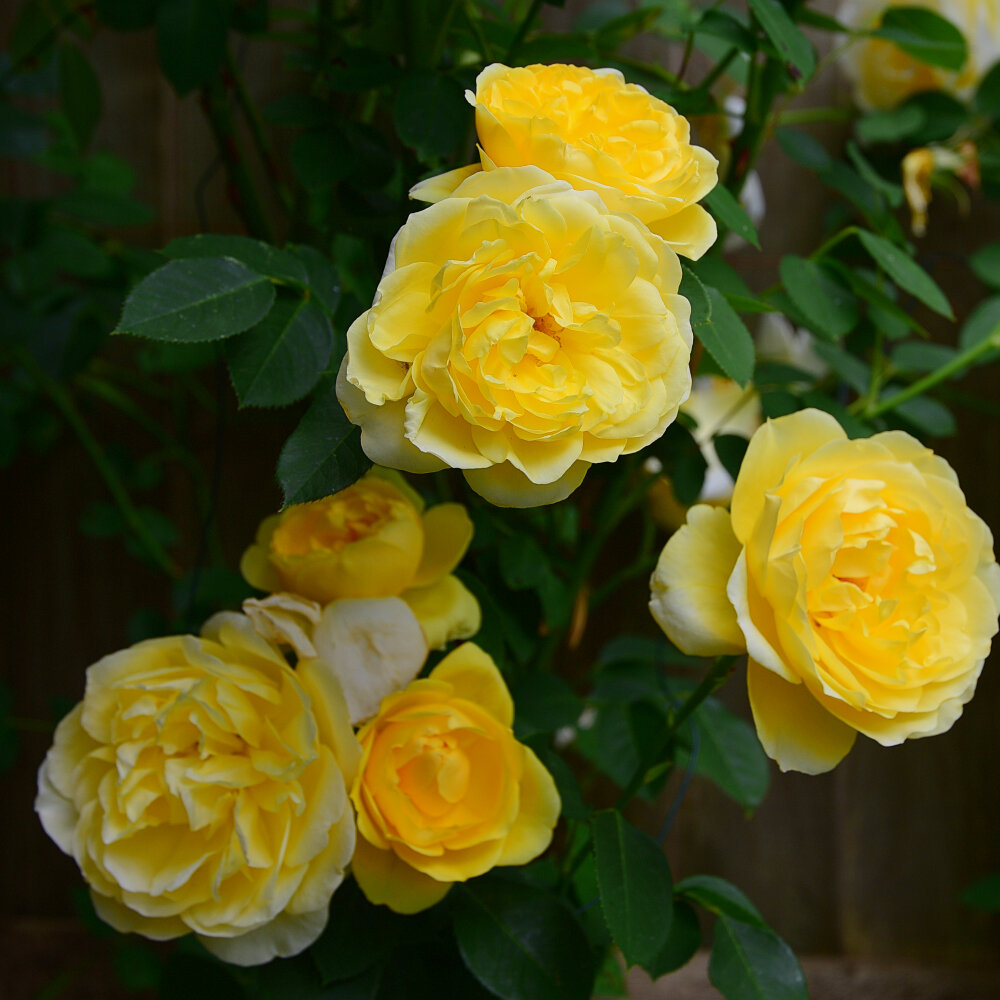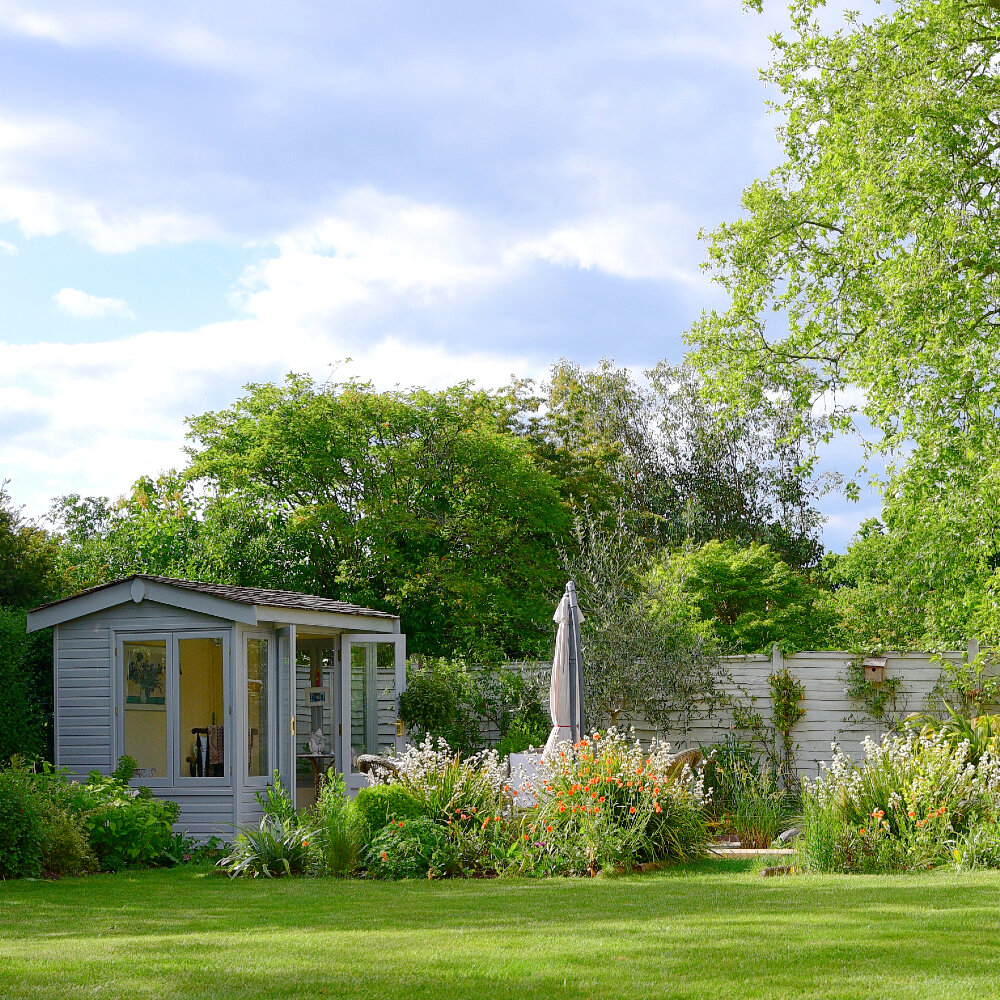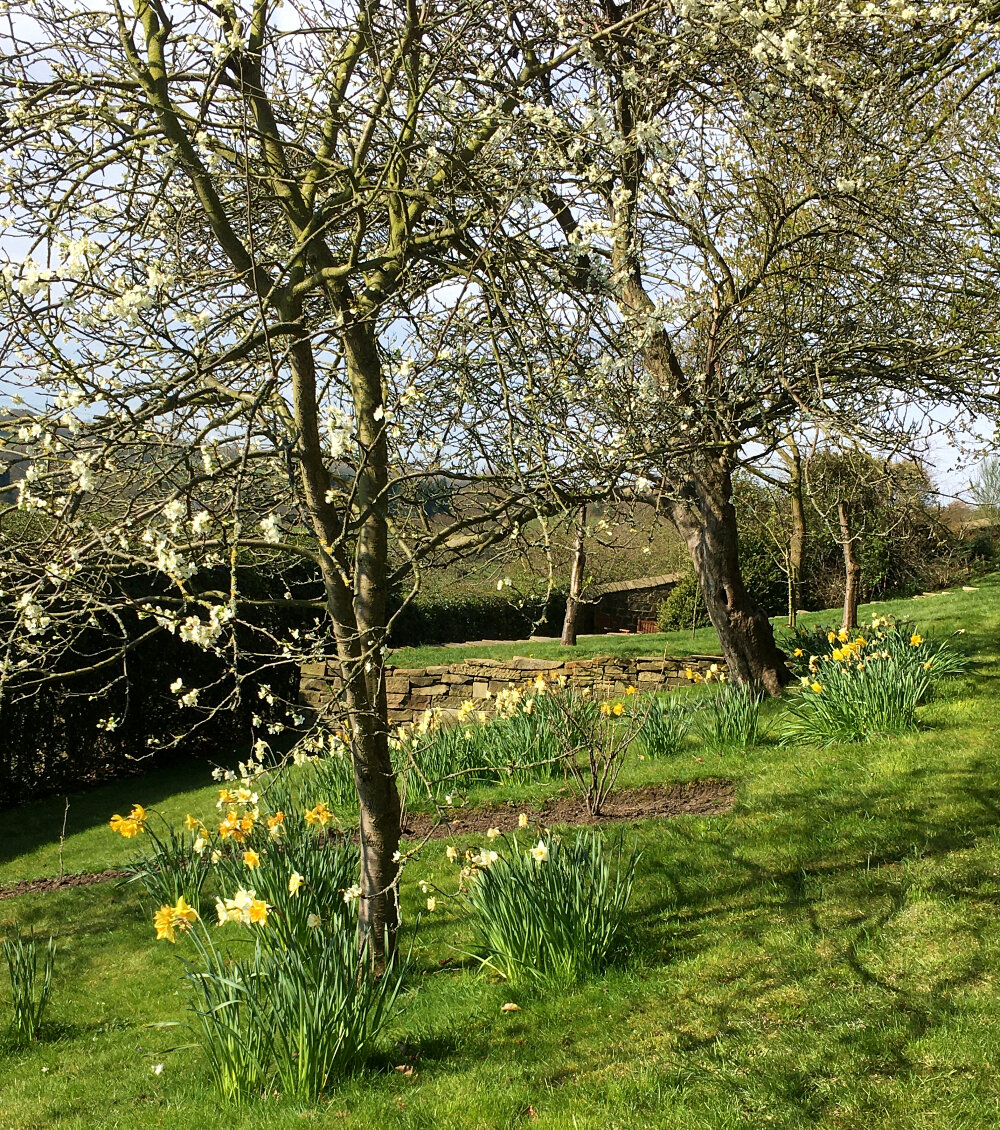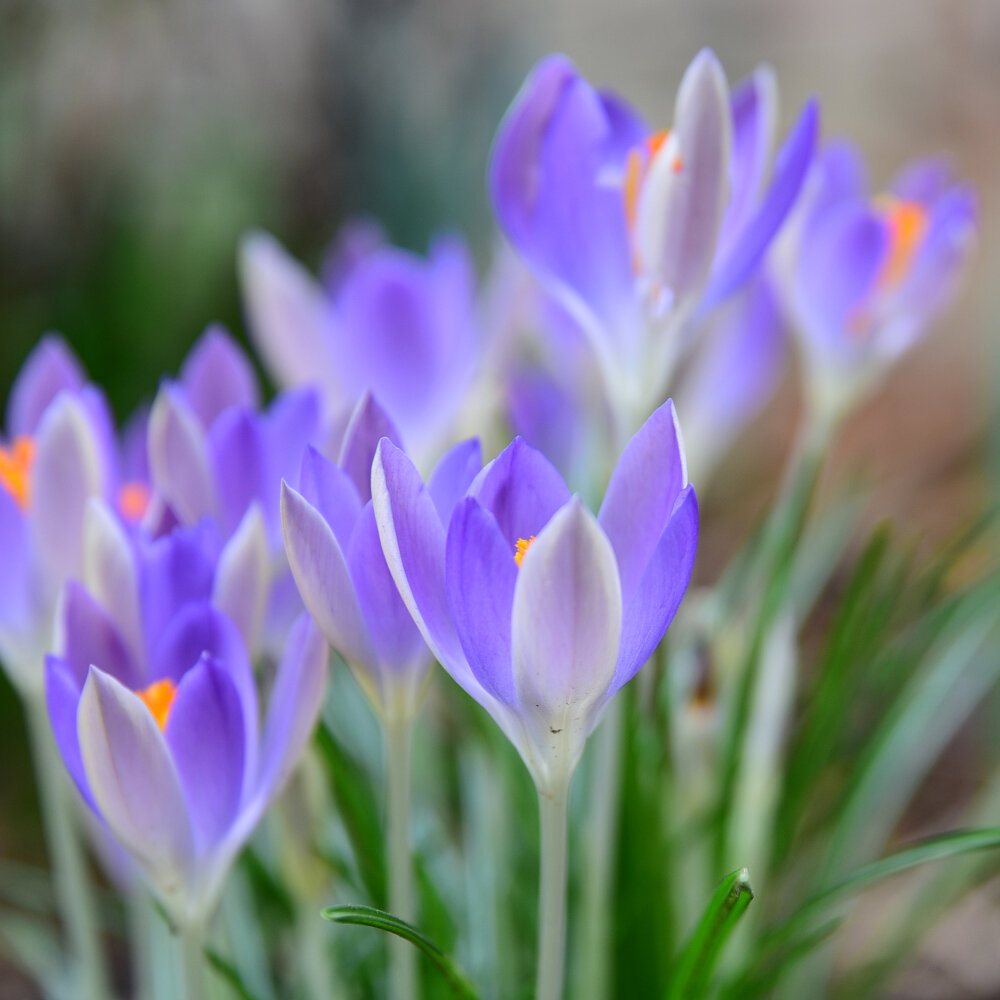The Hepworth Wakefield Garden
I was not overly hopeful of enjoying the Hepworth Wakefield Garden. Often gardens that seem good looking on social media are somewhat disappointing in real life. And the long journey up the M1 had been dreary and wet, compounding my low expectations.
The Hepworth Wakefield Garden
So it was a really pleasant surprise to find that it was all it was cracked up to be and, not only that, the sun came out just as I arrived.
The garden was designed by Tom Stuart Smith and according to thee garden’s website the “design draws inspiration from its unusual setting between 19th-century red-brick mills and a 21st-century art gallery. It echos the striking, angular shapes of the David Chipperfield-designed gallery while harnessing a naturalism that reflects Barbara Hepworth’s deep connection to the landscape.”
Rhus typhina and Aconitum
Construction began in 2019 and is planted with 14,000 perennials, 120 metres of beech hedge, 52 trees and shrubs and 60,000 bulbs.
Rhus typhina and grasses
In autumn the main features of the garden are the brilliantly-leaved Rhus typhina, grasses and various asters, all looking really good backlit by low autumn sun. I can’t say that Rhus is a favourite plant of mine, it has a tendency to sucker and spread, but in autumn the colour is hard to beat.
Rhus typhina
Phlomis russeliana seedheads
Asters and Echinacea seedheads
I sometimes find it hard to persuade clients that it’s worth planting for autumn colour and form. Despite the much-lauded value of grasses and seedheads it’s not until people see gardens like this in autumn that they become convinced.
Pennisetum and Salvia (formerly Perovskia) Little Spire
Back-lit grasses and asters
Euphorbia and Echinacea seedheads
More grasses and asters
One plant I was delighted and surprised to see in a public garden was the bright blue Aconitum. I’m not sure which variety it is but it’s stunning in the half shade under an oak tree. Most Aconitum are poisonous and although some have AGM status they should always be handled with care; ingesting even a small amount can make you seriously unwell and can cause death. Here it is placed well back in the border and does not overhang the lawn or paved areas.
Aconitum, to be handled with care…
There is a small cafe in the garden (closed when I was there) and a cafe inside the gallery. The garden is free to enter, though you do have to pay for parking close by on the other side of the River Calder.
Sculpture by Michael Craig-Martin
Long view
Fading into beautiful light
It was well-worth the long schlep up to Wakefield (on my way to meet up with friends really…) and proved every bit as good as it looks on Instagram - @katymerrington. It is beautifully maintained by cultural gardener Katy Merrington and a team of volunteers.
Sussex Prairies
I first visited Sussex Prairies about ten years ago. It had only been open a couple of years then and on a dreary day late in October it had been hard to imagine how it would develop. However, I did remember the cakes had been rather good.
It’s safe to say things have turned out pretty well. If you are still in denial that summer has ended a couple of hours here would confirm your suspicions. Not only was it clear that most schools were still on holiday but I’m pretty sure the gardens were at their absolute peak.
The gardens are the work of Paul and Pauline McBride who have spent their whole careers developing gardens, mostly overseas. The gardens here are inspired by their experience of working with Piet Oudolf, champion of the “prairie” or “new perennial” style of planting.
The prairie reference relates the the north American origin of many of the plants used. (And hence, I suppose, is the reason for these buffalo wandering through.) The main features of this style of planting are the long season of interest, large groupings of the same plant in loose waves, a lot of ornamental grasses and few shrubs or evergreen structural plants.
And when I see it decribed like that the words don’t do it justice. Most of the flowers and grasses are tall, colourful, and with different forms. Walking through narrow paths in the middle of the planting is a really fantastic experience.
The borders are alive with pollinators and a couple of deep ponds provide habitats for other beneficial garden visitors. From memory I think the plants are left standing through the winter and are then strimmed and/or burned (another prairie feature?). The strimmed plants are chopped up and put back on the borders as mulch. Minimal inputs, minimal outputs.
The design of the borders is based on the spiral of a nautilus shell, not that it’s noticeable from the ground. At one end of the eight acre site the borders are raised up a few metres, giving good views across the gardens.
Although the planting emphasis is large groupings of single species it’s hard to keep nature completely under control. I found myself coming back to this small mix of dark mauve Eurybia x hervyi Twilight and the barley like grass Hordeum jubatum. For the purposes of clarity, Eurybia is the new name for most asters (don’t ask).
I also really liked the McBride’s house, just on the edge of the gardens. I think the living areas are on the first floor, imagine the views..
At the beginning of September it’s great to see which flowers are still going strong so late in the season. Here were have Heleniums and Solidago, and the other main ones are Persicaria, Echinacea, Rudbeckia, Sanguisorba, Gaura, Eupatorium, Hylotelephium (formerly Sedum), and of course most ornamental grasses.
The cake is still good. I had the guest cake - cherry, pistachio and coconut. The coffee is so-so. Bring a packed lunch if you visit though as there’s not too much else on offer.
You don’t need to book an entry time here and the garden’s so big social distancing is not a problem. The gardens are immaculate, unlike a National Trust one I visited recently, and it only cost £9 to get in. VFM.
Dahlia mania - the Exotic Garden at Wisley
On the wettest August day in a long time I thought it would be a good idea to visit RHS Wisley. How wet could it be I thought …
The Glasshouse Borders were looking windswept and the Long Borders were a little past their best but the Exotic Garden was still looking on top form.
The big leaves, bright colours and lushness of the Exotic Garden reminded me a little bit of Barbados. Even the rain added to the atmosphere. Here, the huge leaves of bananas and Cannas provide the jungly backdrop to the brightly coloured Canna flowers and the slightly more delicate and papery bells of orange Abutilon flowers.
Cannas are hungry plants and need to be well-fed and watered through the growing season. In milder areas you can keep them in the ground through winter. The flowers are pretty showy but it’s the leaves I really like. Often they are striped and multi-coloured.
The most recognisable highlights of the Exotic Garden though are the Dahlias. There were dozens of different varieties dotted around, however, very few of them were named - not very RHS I thought.
Many of you will know that Dahlias are enjoying a resurgence in popularity after years in the doldrums. Originating in Mexico they are relatively easy to grow in the UK if you follow a few simple rules. They make excellent flowers for cutting.
Dahlias prefer rich, free draining soils so if you’re gardening on heavy, unimproved clay you’ll need to lift them after the first frost. When planting new ones make sure it’s after the last frost of spring.
Many Dahlias have very large flowers and/or can reach heights of six feet. In these cases they’ll need staking - do it sooner rather than later.
Dahlias really benefit from regular feeding - you can use diluted tomato food twice a week. And dead-heading prolongs flowering.
The flowers come in lots of different colours and shapes. The National Dahlia Society has 14 different flower shape types (including miscellaneous). Generally, the simpler the shape the better the flower is for pollinators.
Dahlias can be prone to attacks from slugs and snails just as they are getting going and later from aphids and earwigs so keep an eye out for them.
Most people find them a delight to grow and their sheer exhuberance makes them the highlight of late summer and early autumn.
RHS Wisley is open every day and generally you have to book a timed entry. However, as the day I went was so wet many people had cancelled and I was able to get in without booking. I did call first to check though.
The shopping and catering facilities have increased vastly since my last visit (as has the size of the carpark - be prepared to walk upto a couple of hundred yards just to get to the entrance).
By the way, the rain stopped just before it closed, pretty wet then.
Readers Gardens June 2020
The partial lift of lockdown measures hasn’t applied to public gardens. It’s just as well we’ve still got lots of readers’ gardens to visit.
Liz and Stephen
Starting in my neighbourhood with Liz and Stephen’s garden in one of the nicest roads in Wimbledon. You may remember this garden from last year when we replanted quite a bit of it.
One more growing season on and it’s really filled out. Liz has planted some more tulips and these ones, which I think are called Greenland, have lasted a really long time.
With an eye for a bargain Liz found these bright orange Geum borisii to complement the lighter-coloured Geum Totally Tangerine. Different tints of the same colour always work well together.
Some of the borders are edged with Erigeron karvinskianus. This hard working perennial flowers from May until November, it doesn’t need dead-heading and does a really good job of smothering weeds.
And at the end of the garden, starting to drape itself over the summerhouse, is Rosa Graham Thomas, surely one of the prettiest yellow roses.
Susanna and Richard
Across the other side of Wimbledon in the grounds of a charming house is a very different type of garden. When I met Susanna and Richard they were in the middle of a garden revamp, almost all the landscaping of which was done by Richard. This included rebuilding the cedar surround to a large koi carp pond, a bridge and a fab black garden room.
The wild flower meadow, under an amazingly productive quince tree, has been here for some time. In late May it’s just starting to get going.
I love the way the wild flowers are spilling over the paving, the shadows are really clear.
Susanna’s the one with the good taste, selecting a really nice palette of textured greens for the shady part of the garden. I’m looking forward to seeing this one when lockdown’s properly over.
Len and Barbara
To the country now and one of the first gardens I designed. There have been a few changes over the years. A couple of new borders have been added along with a smart summerhouse.
Len’s in charge of the lawn and raising a lot of plants, like these calendula, from seed. Barbara decides where they go.
The garden has matured in a really nice way and I like the intermingling of plants, like these Viburnum, Euphorbia and Lamium.
Barbara’s real pride and joy though are the large box balls, lovingly cared for over many years. Followed closely by an army of Alliums, these are Purple Sensation.
Readers' gardens - April 2020
As I can’t get out and about and do my normal, if sporadic, review of gardens my mother suggested I feature some of my readers’ gardens. And quite a few have obliged with some photos. Apologies in advance for a bit of editing…
Helen’s garden
Helen gardens in the grounds of a south-facing London mid-terrace. The standout feature here is the beautiful multi-stemmed Acer at the back. Unfortunately neither of us knows the name.
The view from underneath is pretty impressive.
Helen (along with my dad of course) is one of my veg gurus, although she does have a strange prediliction for beans which I hate. She’s pretty good at bulbs in containers as well, these are Tulipa Queen of the Night, one of my favourites.
Rachel and Peter’s garden
Up to the far north of England now where it’s still winter really. Deep in the heart of the rhubarb triangle Rachel and Peter garden in the grounds of a magnificent rectory with great views.
You’ll have noticed it’s proper gardening up here - wheelbarrows, wellies, outside lavs, old Barbours and flatcaps are a must. But alas there’s no whippet on a bit of string.
On the plus side there’s room for a mini-orchard and dry-stone walling. The latter is put to good use to block up the vicar’s gate into the garden.
Desna and Rob’s garden
Back to London and a garden in the grounds of an Edwardian terrace. One can see immediately that this is a cool garden, not least because it was designed by yours truly.
It’s been a few years now and Desna and Rob have made it their own. Finally they got the steamer chair I’ve been nagging them about. You can see what the garden used to look like here https://www.arthurroadlandscapes.co.uk/designs#/balham-courtyard-garden/. Very good barbecues are to be had here, luckily Rob did not include the BBQ in the photo.
This is a garden that really comes into it’s own later in the summer when Desna’s amazing dahlias hit their stride. We may come back then…
Nicola’s garden
A few miles further south-west is Nicola’s garden, in the grounds of a nice Edwardian semi. I have to admit to a bit of cheating here, this is a garden I designed and also maintain so the photos are mine (perhaps I shouldn’t have said that).
We revamped the garden quite a bit last year and I planted a lot of new bulbs. You can read about the update here https://www.arthurroadlandscapes.co.uk/blog-/2019/8/14/breathing-new-life-into-a-teddington-garden
Somehow though a few rogue red and yellow ones have popped up to interrupt my purple and pink scheme. They’re safe for now but as soon as they’ve finished flowering…
These crocuses are nothing to do with me but every time I see them I think I should plant some more.
A big thankyou to everyone who volunteered for this article…. If you’d like your garden to be featured next time please send me some photos by 20 April.
8 Easy ways to "green up" your garden
New year, new resolutions? You can’t have seen any of the news recently and wondered how on earth you could really make any difference to your environment. This might help; doing just one of these is something.
The two best things you can to green up your garden are to reduce inputs and outputs - water, fertilizer, compost, plastic, pesticides and increase bio-diversity - grow more, encourage wildlife, be less tidy.
1 - Get a water butt
I know, this isn’t going to eliminate the need for running a hose in your garden, especially given how hot recent summers have been here in London. But, 350 litres of water, filled several times by torrential downpours, will make a difference. And they’re not all unattractive and they are also pretty easy to install.
2 - Make your own fertilizer
You’ve seen this plenty of times on Gardener’s World - steep comfrey leaves in water for a few weeks. You know it’s done when the smell gets really bad, then water your tomatoes and flowers with it. And get or make a compost bin.
3 - Mulch
What to do with all those autumn leaves? Collect them and store them in bags with a few holes, or wire cages. The resulting compost can be spread on your flowerbeds in spring. This helps keep down weeds, improves the texture of your soil (especially clay) and reduces the need for watering.
4 - Recyclable plant pots
As you probably know black plastic plant pots can’t be recycled. It’s something to do with the black colouring. But many nurseries are moving to using taupe-coloured pots which can be recycled kerb-side. You can also buy plants in compostable pots. If you’ve got a choice make the right one. And if you haven’t then try and re-use your black plastic pots rather than chucking them away.
5 - Natural pesticides and herbicides
It’s easier to work with nature rather than fight it. Encouraging birds, hedgehogs, frogs and toads will help with insect control. Weeds in your patio means it needs re-pointing not weedkiller. And weeding your flowerbeds is good for you. It doesn’t matter if you don’t get them all. Use companion planting to help keep pests off your veg and if things are really bad try using nematodes to get rid of persistent pests like vine-weevil. Pheromone traps are good for preventing the box tree moth from breeding.
6 - Grow more
If your garden is a desert of plastic grass or concrete or even strictly-mown lawn then any plants will make a difference. It doesn’t really matter what you plant - most flowers will attract pollinators. Almost all trees are hosts to many beneficial insects and birds, produce flowers and often some sort of edible fruit and leaves for mulch. They provide shade which helps reduce evaporation and heat, and many trees help reduce airborne pollution. Growing your own fruit and veg is healthy, tastes great and saves you money. All plants lock up carbon. Trees lock up the most and for the longest.
7 - Encourage wildlife
Feed the birds, consistently, all through the winter. And plant things they will like - trees and plants to attract insects. Install a bird bath or mini pond - an upturned dustbin lid will do. Birds will use it to drink and wash, even insects need to drink, frogs may spawn in it and hedgehogs, bats and voles will enjoy it too. Install bird boxes and insect hotels. As long as they’re in the right spot they will get used.
8 - Be untidy
The easiest thing of all. Keep a corner of your garden untouched. Let the weeds grow, leave it undisturbed. Many mammals and invertebrates will make it home. Others will forage for food and nesting material. Don’t be in a rush to tidy up your the rest of your garden in the autumn. Leave flowers and grasses standing until the spring - seedheads provide food, dead foliage is used for nesting, standing stems create a micro-climate out of the worst of the winter weather.
Do one thing.


